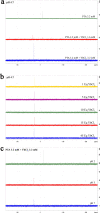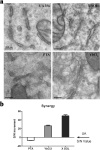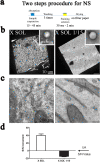Uranium-free X solution: a new generation contrast agent for biological samples ultrastructure
- PMID: 32665608
- PMCID: PMC7360580
- DOI: 10.1038/s41598-020-68405-4
Uranium-free X solution: a new generation contrast agent for biological samples ultrastructure
Abstract
Biological samples are mainly composed of elements with a low atomic number which show a relatively low electron scattering power. For Transmission Electron Microscopy analysis, biological samples are generally embedded in resins, which allow thin sectioning of the specimen. Embedding resins are also composed by light atoms, thus the contrast difference between the biological sample and the surrounding resin is minimal. Due to that reason in the last decades, several staining solutions and approaches, performed with heavy metal salts, have been developed with the purpose of enhancing both the intrinsic sample contrast and the differences between the sample and resin. The best staining was achieved with the uranyl acetate (UA) solution, which has been the election method for the study of morphology in biological samples. More recently several alternatives for UA have been proposed to get rid of its radiogenic issues, but to date none of these solutions has achieved efficiencies comparable to UA. In this work, we propose a different staining solution (X Solution or X SOL), characterized by lanthanide polyoxometalates (LnPOMs) as heavy atoms source, which could be used alternatively to UA in negative staining (NS), in en bloc staining, and post sectioning staining (PSS) of biological samples. Furthermore, we show an extensive chemical characterization of the LnPOM species present in the solution and the detailed work for its final formulation, which brought remarkable results, and even better performances than UA.
Conflict of interest statement
The authors declare no competing interests.
Figures





References
-
- Benmeradi N, Payre B, Goodman SL. Easier and safer biological staining: High contrast UranyLess staining of TEM Grids using mPrep/g capsules. Microsc. Microanal. 2015;21:721–722. doi: 10.1017/S1431927615004407. - DOI
MeSH terms
Substances
LinkOut - more resources
Full Text Sources
Research Materials
Miscellaneous

